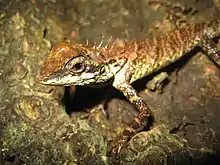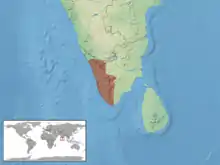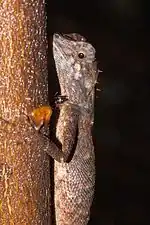Monilesaurus ellioti
Monilesaurus ellioti, or Elliot's forest lizard, is a species of arboreal, diurnal, lizard in the family Agamidae, endemic to the Western Ghats, India.[1][2]
| Monilesaurus ellioti | |
|---|---|
 | |
| Scientific classification | |
| Kingdom: | Animalia |
| Phylum: | Chordata |
| Class: | Reptilia |
| Order: | Squamata |
| Suborder: | Iguania |
| Family: | Agamidae |
| Genus: | Monilesaurus |
| Species: | M. ellioti |
| Binomial name | |
| Monilesaurus ellioti | |
| Subspecies[2] | |
| |
 | |
| Synonyms[2] | |
Etymology
The specific name, ellioti, is in honor of Scottish naturalist Walter Elliot.[3]
Distribution range
This species is endemic to Western Ghats. This species is found in Agasthyamalai, Cardamom Hills, Palni Hills, Anaimalai, Nilgiris, Waynad, Coorg and Kudremukh. It inhabits rainforest and adjacent plantations like coffee, cardamom and tea estates and even in Areca and vanilla plantations.
Description
E.jpg.webp) Lateral view
Lateral view Head
Head_by_Sandeep_Das.jpg.webp) Head
Head
The upper head-scales of M. ellioti are feebly keeled, imbricate, much enlarged on supraorbital region; a small spine behind the supraciliary edge, and two others on each side, the anterior midway between the nuchal crest and the tympanum, the posterior just above the latter, which measures nearly half the diameter of the orbit. Gular sac not developed; gular scales strongly keeled, smaller than the ventrals. A strong oblique fold or pit in front of the shoulder, and a transverse gular fold. Nuchal crest composed of a few widely separated slender spines, the longest of which measures about two thirds the diameter of the orbit; dorsal crest a mere denticulation. 53 to 61 scales round the middle of the body; loreal scales of nearly the same size as the ventrals, keeled, the uppermost with the points directed straight backwards, the others directed downwards and backwards; ventral scales strongly keeled. The adpressed hind limb reaches the anterior border of the orbit or the tip of the snout; fourth finger longer than third. Tail scarcely compressed. Olive above, with more or less distinct angular dark-brown, cross bands on the body ; an angular black mark on each side of the neck; a white spot below the orbit, dark lines radiating from the eye.[4]
From snout to vent 3 in (7.6 cm); tail 8.5 in (22 cm).
References
- Srinivasulu C, Srinivasulu B, Vijayakumar SP, Ganesan SR, Prabhu M, Madala M (2013). "Monilesaurus ellioti". IUCN Red List of Threatened Species. 2013: e.T170381A1312752. doi:10.2305/IUCN.UK.2013-1.RLTS.T170381A1312752.en.
- Calotes ellioti at the Reptarium.cz Reptile Database. Accessed 17 January 2015.
- Beolens, Bo; Watkins, Michael; Grayson, Michael (2011). The Eponym Dictionary of Reptiles. Baltimore: Johns Hopkins University Press. xiii + 296pp. ISBN 978-1-4214-0135-5. (Calotes ellioti, p. 82).
- Boulenger GA (1890). The Fauna of British India, Including Ceylon and Burma. Reptilia and Batrachia. London: Secretary of State for India in Council. (Taylor and Francis, printers). xviii + 541 pp. ("Calotes ellioti [sic]", pp. 142-143).
Further reading
- Boulenger GA (1885). Catalogue of the Lizards in the British Museum (Natural History). Second Edition. Volume I. ... Agamidæ. London: Trustees of the British Museum (Natural History). (Taylor and Francis, printers). xii + 436 pp. + Plates I-XXXII. ("Calotes elliotti [sic]", pp. 330-331 + Plate XXV, figure 3).
- Das I (2002). A Photographic Guide to Snakes and other Reptiles of India. Sanibel Island, Florida: Ralph Curtis Books. 144 pp. ISBN 0-88359-056-5. (Calotes ellioti, p. 71).
- Günther A (1864). The Reptiles of British India. London: The Ray Society. (Taylor and Francis, printers). xxvii + 452 pp. + Plates I-XXVI. ("C. elliotti [sic]", new species, p. 142).
- Smith MA (1935). The Fauna of British India, Including Ceylon and Burma. Reptilia and Amphibia. Vol. II.—Sauria. London: Secretary of State for India in Council. (Taylor and Francis, printers). xiii + 4440 pp. + Plate I + 2 maps. ("Calotes elliotti [sic]", pp. 207-208).
External links
| Wikimedia Commons has media related to Calotes ellioti. |
- "Monilesaurus ellioti GÜNTHER, 1864". The Reptile Database.
- http://novataxa.blogspot.com/2018/09/monilesaurus.html
